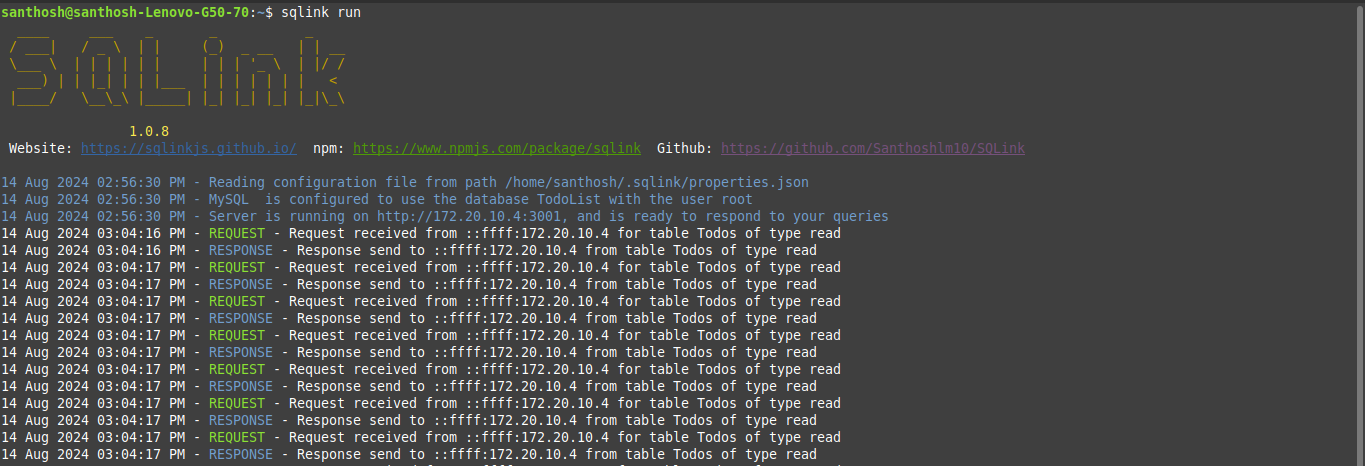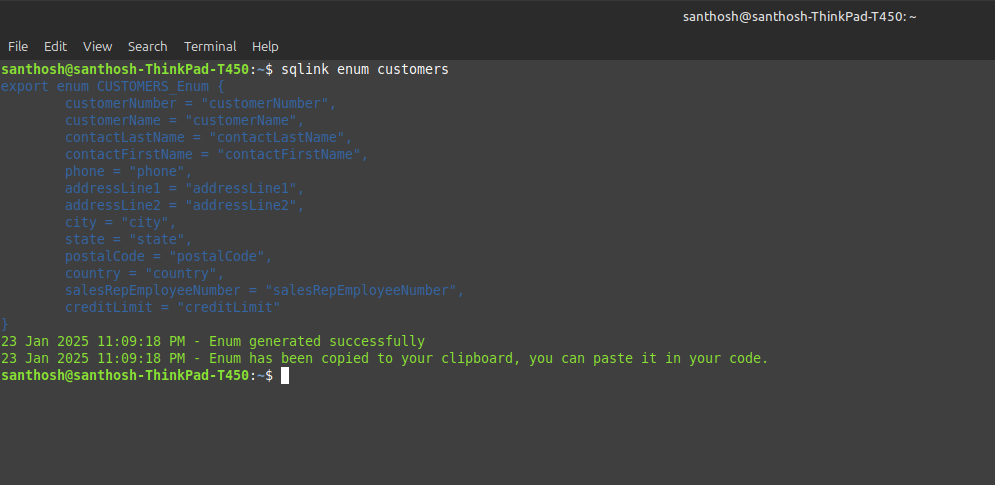
SQLink Documentation

SQLink Documentation
Welcome to SQLink documentation, browse the latest APIs and code samples
Introduction
SQLink is a free and open-source Node.js library designed to simplify database interactions by providing ready-to-use APIs for MySQL. With SQLink, developers can easily perform essential database operations such as reading data (GET), creating new entries (POST), updating existing records (PUT), and deleting data (DELETE) without having to manually code these functionalities.
Additionally, SQLink offers built-in support for executing stored procedures, allowing you to pass arguments and handle more complex database logic seamlessly.
This library significantly reduces the time and effort required during the development process, particularly for those who want to focus on front-end development or need to quickly prototype their applications. Whether you're working on a personal project, learning new skills, or building a prototype, SQLink provides a robust solution that accelerates development by handling the backend for you.
Getting Started
Open your terminal and enter the following command to install sqlink
$ npm install -g sqlinkOnce you install the package successfully, verify it by using the command as shown below
$ sqlink --version
1.0.8Command line options
Type sqlink -h to see the available options.
$ sqlink -h
Usage: sqlink [options]
SQLink is a Node.js library that turns MySQL tables into RESTful APIs with procedure execution and full CRUD support.
Options:
-V, --version output the version number
run runs the sqlink program
update updates the library
config updates mysql configuration from CLI
-h, --help display help for commandRunning the program
Type sqlink run to run the program.
$ sqlink run
____ ___ _ _ _
/ ___| / _ \ | | (_) _ __ | | __
\___ \ | | | | | | | | | '_ \ | |/ /
_) | | |_| | | |___ | | | | | | | <
|____/ \__\_\ |_____| |_| |_| |_| |_|\_\
1.0.8
Reading configuration file from ./properties.json
MySQL connection completed with user root
Server is running on http://172.20.10.4:3001
Sending Request to SQLink
Once sqlink program is started succesfully, you can start to query the data using postman or any other REST API tools
For any request recevied from the client there will be a log printed in the console and also for the response sent from sqlink. a sample screenshot is attached below

Configuration
To update the configuration of sqlink package, type the following command in your terminal
$ sqlink configAfter executing the command, you will be prompted a input few details regarding MySQL and server port.
$ sqlink config
Please provide your MySQL configuration for connection
? Enter your MySQL host: (localhost)
? Enter your MySQL user: (root)
? Enter your MySQL password: ***********
? Enter Database name:(your database name)
? Enter your MySQL port:(3306)
? Enter the port where app needs to be hosted: (3001)Once you enter the valid details and hit enter, next time you run sqlink run, the configuration will be applied
Reading Data
In MySQL, reading data involves retrieving records from a table. This process allows you to access and view the stored information, often filtering or sorting the data to meet specific requirements.
Usage
URL:
http://localhost:3000/table/table_name/read(...options)Method
GETResponse:
200 OK$select
selects all the columns in a mysql table(*) or you can query based on column names as well
Selected parameters
http://localhost:3000/table/users/read?$select=*Selected parameters
http://localhost:3000/table/users/read?$select=username,useremail,city$filter
filters the records based on the given condition
Example
http://localhost:3000/table/users/read?$select=*&$filter=name eq 'john'Filter query options
| Filter option | Notation | Description |
|---|---|---|
| Equals to | eq | Returs if the column matches the provided value |
| AND operator | and | Takes more then one condition as input and returns if both parameters matches the condition |
| OR operator | or | Takes more then one condition as input and returns if any parameter matches the condition |
| Not Equals to | ne | Inversion of equals to operator |
| Lesser than | lt | Returns if the value of the column item is lesser than the reference value |
| Lesser than or equal to | le | Returns if the value of the column item is lesser than or equal to the reference value |
| Greater than | gt | Returns if the value of the column item is greater than the reference value |
| Greater than or equal to | ge | Returns if the value of the column item is greater than or equal to the reference value |
$orderby
Orders the query based on the provided column name in ascending or descending order
Ascending order
http://localhost:3000/table/users/read?$select=*&$orderby=nameDescending order
http://localhost:3000/table/users/read?$select=*&$orderby=name desc$top
Works similar to limit query of mysql (returns number of records based on the given limit)
Example (Returns top 5 users)
http://localhost:3000/table/users/read?$select=*&$orderby=name desc&$top=5$skip
Takes the number of records that needs to be skipped for a given query (Useful when paginating)
Example (skip 5 records)
http://localhost:3000/table/users/read?$select=*&$orderby=name desc&$top=5&$skip=5Inserting Data
In MySQL, inserting data refers to adding new records into a table. This process populates the table with fresh entries, each containing specific values for the defined columns.
Usage
URL:
http://localhost:3000/table/table_name/createMethod
POSTPayload
{
column1: "value1",
column2: "value2",
column3: "value3",
column4: "value4"
}
Response:
200 OKResponseExample
URL:
http://localhost:3000/table/table_name/createPayload
{
username: "John Doe",
useremail: "johndoe@email.com",
city: "Bangalore",
}
This API will insert a record in users table
Updating Data
In MySQL, updating data involves modifying existing records in a table. The update process allows you to change the values of specific fields within rows to reflect new information or correct inaccuracies.
Usage
URL:
http://localhost:3000/table/table_name/update(update_key,update_value)Parameters
Method
PUTPayload
{
column1: "updated_value1",
column2: "updated_value2"
}
Response:
200 OKResponseExample
URL:
http://localhost:3000/table/users/update(user_id,10)Payload
{
username: "John Doe",
}
This API will update the record with username as John Doe where user_id is 10
Deleting Data
In MySQL, data is deleted by removing records from a table. Deletion is a process that permanently erases specific rows of data from a database table, reducing the dataset by eliminating unwanted or obsolete entries.
Usage
URL:
http://localhost:3000/table/table_name/delete(delete_key,delete_value)Parameters:
Method:
DELETEResponse:
200 OKResponseExample
URL:
http://localhost:3000/table/users/delete(user_id,10)The URL shown above will select a record from users table where user_id is equal to 10
Hosting Files
This feature allows users to host and access any files on their local machine with a single command.
Command
$ sqlink host YOUR_PORT YOUR_PATH3002).Accessing Hosted Files
Once the hosting command is running, files are accessible through URLs in the following format:
http://localhost:PORT/static/YOUR_FILE_PATHReplace YOUR_FILE_PATH with the relative path to the specific file from
the hosted directory. For instance, if you are hosting a file at /home/user/docs/file.txt and
started the server with sqlink host /home/user/docs 3002, the access URL would be:
http://localhost:3002/static/file.txtExample
sqlink host /home/user/documents 3002/home/user/documents3002http://localhost:3002/static/sample.txt (for
/home/user/documents/sample.txt)
This setup provides a quick and straightforward way to access files on your local machine over HTTP, making it useful for sharing or accessing files remotely as long as the server remains active.
Uploading Files
This feature enables users to upload files to a specified endpoint and store them on disk.
Endpoint
/uploadPOSTfiles (multipart form-data key)Note: Ensure the field name in the request body is specified as "files".
Any other field name will prevent the file from being uploaded.
USER_BASE_PATH/.sqlink/uploads
{
"success": true,
"data": [
{
"fieldname": "files",
"originalname": "YOUR_FILE_NAME",
"encoding": "7bit",
"mimetype": "text/csv",
"destination": "YOUR_DESTINATION",
"filename": "YOUR_FILE_NAME",
"path": "YOUR_PATH",
"size": 512,
"accessURL": "http://192.168.1.4:3001/file/YOUR_FILE_NAME.csv"
}
]
}
This setup provides a convenient way to store and access uploaded files directly.
Authentication
Authentication is the process of verifying the identity of a user or entity trying to access a system or resource. It is essential in software applications to ensure that only authorized users can access sensitive data and perform specific actions. By confirming the user's identity, authentication helps protect against unauthorized access and potential security threats.
Enabling the Authentication
To enable authentication in your application using sqlink, run the following command in your terminal:
$ sqlink run authThis will activate the authentication module, allowing users to register, log in, and receive tokens for accessing protected resources. The authentication library in sqlink uses JSON Web Tokens (JWT) for secure, stateless authentication. Upon successful login, a JWT token is generated and returned to the user, which can then be used for authorized access.
Authentication APIs
1. Register a New User
/auth/registerPOSTThis API registers a new user into the system.2. Login a User
/auth/loginPOSTThis API logs in an existing user and provides a JWT token upon successful authentication.
Request Payload (for both APIs):
Both /auth/register and /auth/login endpoints expect
the following JSON payload as input:
Payload:
{
email: "YOUR_EMAIL",
password: "YOUR_PASSWORD"
}
Success Response
If the request is successful, you will receive a 200 OK response from the server.
Generate Enum
Starting from v1.1.8 SQLink provides a feature to generate enums for your project. Enums are a set of named constants that represent a set of possible values. Enums are useful when you have a fixed set of values that are unlikely to change.
Usage
$ sqlink enum YOUR_TABLE_NAMEExample: Generate enum for customers table

As shown in the image above, the enum for the customers table is generated successfully. The enum is also going to be copied to the clipboard for easy access 😊.
Procedures
MySQL procedures are a powerful feature that allows you to encapsulate a sequence of SQL statements into a single unit that can be executed repeatedly with different inputs. Stored procedures are often used to streamline and automate repetitive database tasks, enforce business logic, and enhance the security of database operations
Usage
URL:
http://localhost:3000/procedure/procedure_nameMethod:
GETResponse:
200 OKResponseExample
URL:
http://localhost:3000/procedure/topFiveUsers()Example with params
URL:
http://localhost:3000/procedure/topFiveUsers('Male')The arguments for procedure depends on the number of arguments that the procedure takes which is decided when creating a procedure
Upgrade Package
To update the sqlink package, open your terminal and type the following command
$ sqlink upgradeAfter executing the command, please wait a few seconds for the package to update. You should then be able to see the results.
$ sqlink upgrade
Package updated successfully!!You can verify if the installed package is the latest version
$ sqlink --version
1.0.7Distinct Query
In MySQL, a `DISTINCT` query involves retrieving unique records from a table by eliminating duplicate entries. This process allows you to access only the distinct values from the specified columns, ensuring that each result is unique according to the criteria set in the query.
Usage
URL:
http://localhost:3000/table/table_name/distinct(column_name)Method
GETResponse:
200 OKResponseExample
URL:
http://localhost:3000/table/users/distinct(username)This API will return distinct values of username from users table
Upserting Query
An upsert operation is a database action that combines the functionalities of update and insert operations. When performing an upsert, the database checks if a specific record (usually identified by a unique key or primary key) already exists:
Usage
URL:
http://localhost:3000/table/table_name/upsert(id,value)Method
POSTPayload
{
column1: "value1",
column2: "value2",
column3: "value3",
column4: "value4"
}
Response:
200 OKResponseExample
URL:
http://localhost:3000/table/users/upsert(userid,10)Payload
{
username: "John Doe",
useremail: "johndoe@email.com",
city: "Bangalore",
}